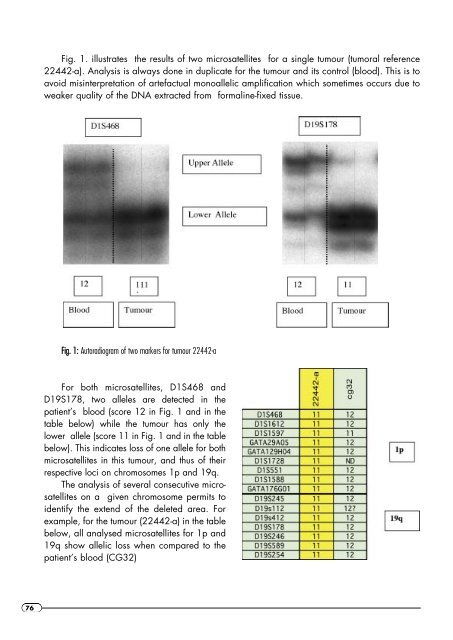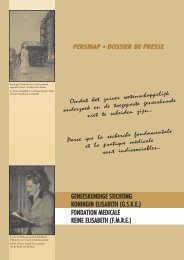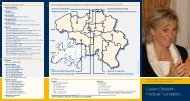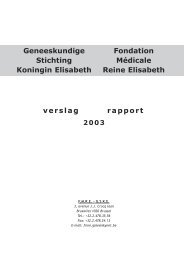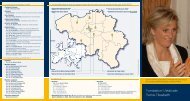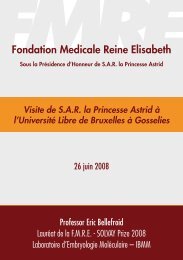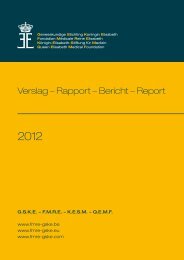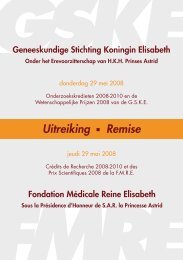- Page 1 and 2:
Geneeskundige Stichting Koningin El
- Page 3 and 4:
Fondation Médicale Reine Elisabeth
- Page 5 and 6:
L’abondance et la qualité des pu
- Page 7 and 8:
Prof. Dr. A. Bossuyt Secrétaire du
- Page 9 and 10:
Prof. Dr. G. Orban Lab. voor Neuro-
- Page 11:
Reports of the University Research
- Page 14 and 15:
14 Members of the team: Christophe
- Page 16 and 17:
16 domains, most notably that of N-
- Page 19 and 20:
Report of the Research Group of Pro
- Page 21 and 22:
Part 1: Characterisation of noradre
- Page 23 and 24:
Part 2 : Chromogranins as neuro-imm
- Page 25: Publications 2000 : • J. Depreite
- Page 28 and 29: 28 Collaborations with: A. Volny-Lu
- Page 30 and 31: 30 MATERIALS AND METHODS Surgery an
- Page 32 and 33: 32 RESULTS Recordings were obtained
- Page 34 and 35: 34 Responses to brush stimuli The s
- Page 36 and 37: 36 DISCUSSION This experimental stu
- Page 39 and 40: Report of the Research Group of Pro
- Page 41 and 42: PART 1: Molecular Pharmacology of A
- Page 43 and 44: c) Most insurmountable AT 1 recepto
- Page 45 and 46: dy tested biphenyl-tetrazole derive
- Page 47 and 48: ii) More distant functional respons
- Page 49 and 50: References •Aiyar N, Baker E, Vic
- Page 51 and 52: •Olins GM, Chen ST, McMahon EG, P
- Page 53 and 54: PART 2: The use of Endothelin 1 in
- Page 55 and 56: vasoconstriction, peaked 20 minutes
- Page 57: ACCEPTED • Vanderheyden P.M.L., F
- Page 60 and 61: 60 Prof. Dr. Christophe Erneux I.R.
- Page 62 and 63: 62 tion forming Ins(1,3,4,5)P 4 and
- Page 64: 64 Bibliography •Berridge, M.J. a
- Page 68 and 69: 68 University of Mons-Hainaut Labor
- Page 70 and 71: 70 Works carried out in 2000 1. We
- Page 73 and 74: Report of the Research Group of Pro
- Page 75: Genetic definition of brain tumours
- Page 81 and 82: Report of the Research Group of Pro
- Page 83 and 84: Genetic determinants of mouse brain
- Page 85 and 86: Genomic organization of the Dab1 ge
- Page 89 and 90: Report of the Research Group of Pro
- Page 91 and 92: In vitro studies of the hypothalami
- Page 93 and 94: vitro GnRH release by intact male g
- Page 97 and 98: Report of the Research Group of Pro
- Page 99 and 100: Study on the functional regulation
- Page 101 and 102: Elucidation of the DAT primary sequ
- Page 103 and 104: The role of presenilin-1 in the gam
- Page 105 and 106: Report of the Research Group of Pro
- Page 107 and 108: INTRODUCTION As usual, this activit
- Page 109 and 110: The acquisitions for this study sho
- Page 111 and 112: not lead to the integrative process
- Page 113 and 114: REFERENCES Thesis •Steven Laureys
- Page 115 and 116: • Positron emission tomography in
- Page 117 and 118: Before scanning, subjects practised
- Page 119 and 120: RESEARCH PROGRAM ON MEMORY FUNCTION
- Page 121 and 122: Corticobasal degeneration, motor sl
- Page 123 and 124: Figure 2. Brain Areas Disclosed Dur
- Page 125 and 126: • Cognitive Neuropsychological an
- Page 127 and 128:
Report of the Research Group of Pro
- Page 129 and 130:
Neuregulin signaling regulates neur
- Page 131 and 132:
tein present in neural precursor ce
- Page 133 and 134:
Cell biology for prevention and tre
- Page 135 and 136:
Functional significance of neurorec
- Page 137 and 138:
Spinal Cord Traumatic Lesion Martin
- Page 139 and 140:
A.Schulman, and T.R.Van De Water, B
- Page 141 and 142:
•Identification of PSF, the PTB-a
- Page 143 and 144:
143
- Page 145 and 146:
Report of the Research Group of Pro
- Page 147 and 148:
Brain activations in a dot pattern
- Page 149 and 150:
References •R Vogels, G Sary, P D
- Page 151 and 152:
Report of the Research Group of Pro
- Page 153 and 154:
A Scientific activities 1. Overview
- Page 155 and 156:
4. Purinergic receptors. Purinergic
- Page 157 and 158:
mals also scored higher in anxiety
- Page 159 and 160:
cell clones have been used in these
- Page 161 and 162:
•Ledent C, Valverde O, Cossu G, P
- Page 163 and 164:
• Snell BJ, Short JL, Drago J, Le
- Page 165 and 166:
Report of the Research Group of Pro
- Page 167 and 168:
I. Physiology and physiopathology o
- Page 169 and 170:
nuclei, which are involved in respo
- Page 171 and 172:
Natl. Acad. Sci. USA, 96: 5257-5262
- Page 173 and 174:
in those who did not. In rats sacri
- Page 175 and 176:
(Poster). Abstract of the 4th EURON
- Page 177 and 178:
Report of the Research Group of Pro
- Page 179 and 180:
Positional cloning of the neuronal
- Page 181 and 182:
fragments, 18 expressed-sequence-ta
- Page 183 and 184:
Philadelphia, USA, 3-7 October 2000
- Page 185 and 186:
Report of the Research Group of Pro
- Page 187 and 188:
I. FMRI in Awake Behaving Macaques
- Page 189 and 190:
gressively higher levels of the cor
- Page 191 and 192:
MION was injected into the femoral
- Page 193 and 194:
Future Possibilities Future contras
- Page 195 and 196:
FIGURES Figure 1: FMRI responses in
- Page 197 and 198:
Figure 5: Average percent signal ch
- Page 199 and 200:
Report of the Research Group of Pro
- Page 201 and 202:
FUNCTIONAL MAGNETIC RESONANCE IMAGI
- Page 203 and 204:
explain these search processes. Par
- Page 205 and 206:
205
- Page 207 and 208:
Report of the Research Group of Pro
- Page 209 and 210:
Investigation of the molecular mech
- Page 211 and 212:
tral) cortex compared to non-depriv
- Page 213 and 214:
By comparing the percentual increas
- Page 215 and 216:
altered amino acid residue is equal
- Page 217 and 218:
BIBLIOGRAPHY - 2000 Publications in
- Page 219 and 220:
Soc. Neurosci. Abstr., 2000, vol. 2
- Page 221 and 222:
Report of the Research Group of Pro
- Page 223 and 224:
1. Coding of 3D-shape in macaque in
- Page 225 and 226:
3. Position sensitivity of macaque
- Page 227 and 228:
Publications: •JANSSEN P., VOGELS


